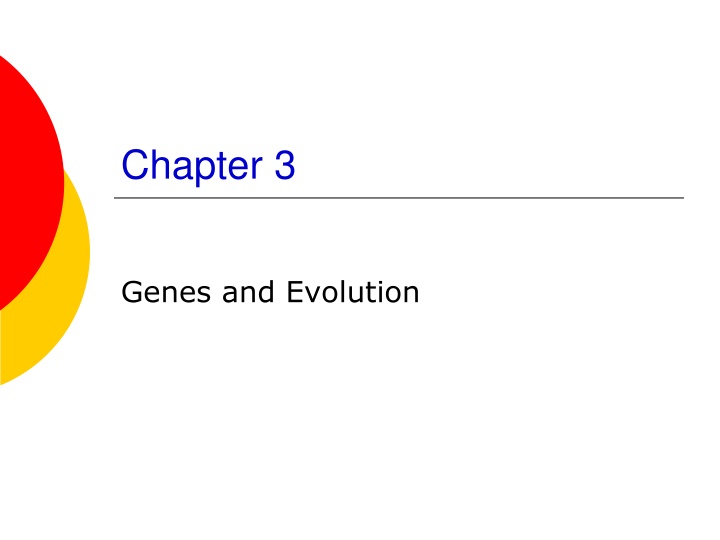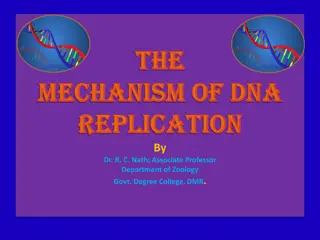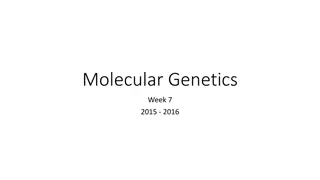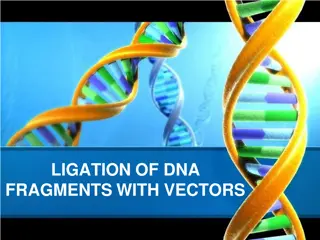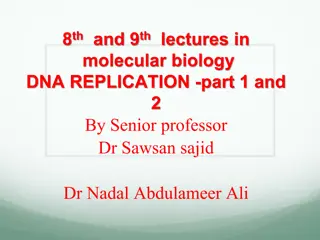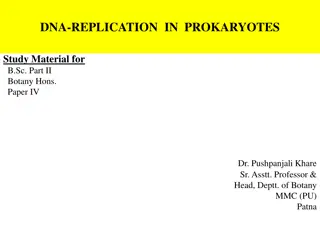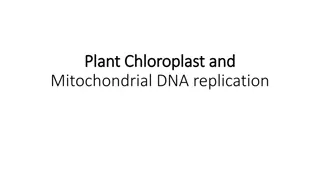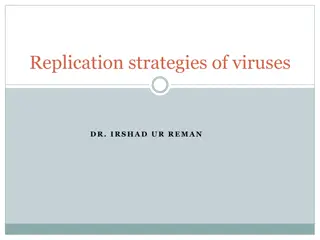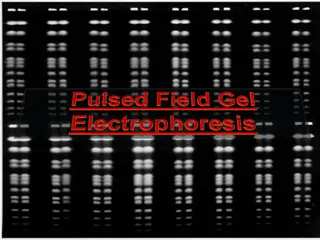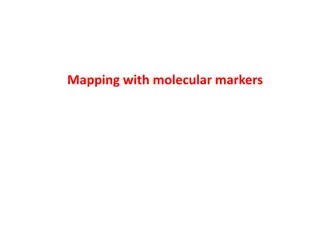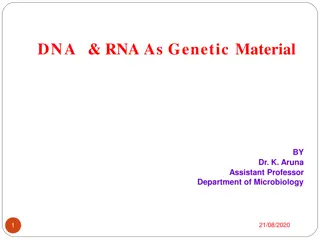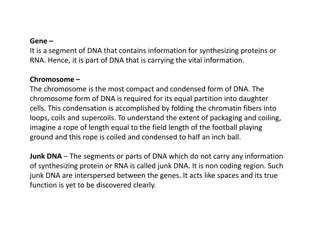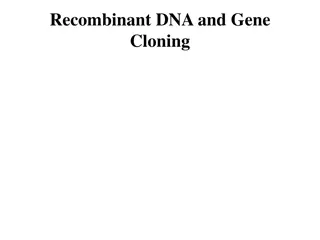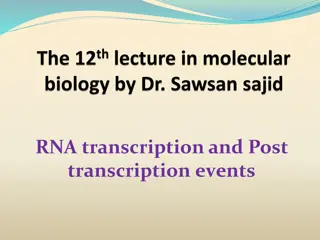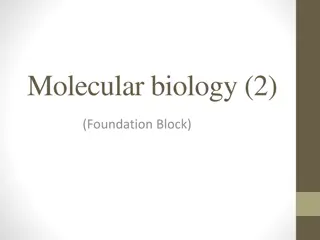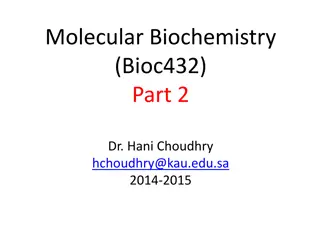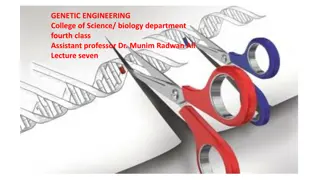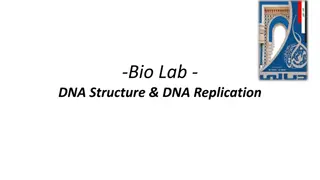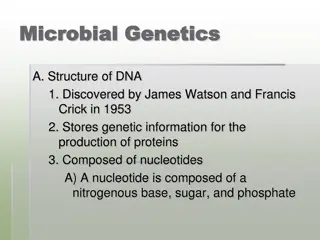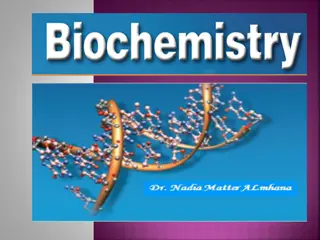Genetic Basis of Behavior and DNA Replication
Each cell contains our genetic code in the form of chromosomes. Genes, segments of DNA, play a crucial role in behavior. Understanding DNA, its sub-units like nucleotides, and bases like Adenine, Thymine, Cytosine, and Guanine is essential. Learn about DNA replication, chromosome structure, cell division through mitosis, and more in this informative content about genes and evolution.
Download Presentation

Please find below an Image/Link to download the presentation.
The content on the website is provided AS IS for your information and personal use only. It may not be sold, licensed, or shared on other websites without obtaining consent from the author.If you encounter any issues during the download, it is possible that the publisher has removed the file from their server.
You are allowed to download the files provided on this website for personal or commercial use, subject to the condition that they are used lawfully. All files are the property of their respective owners.
The content on the website is provided AS IS for your information and personal use only. It may not be sold, licensed, or shared on other websites without obtaining consent from the author.
E N D
Presentation Transcript
Chapter 3 Genes and Evolution
The genetic basis of behaviour Each cell contains our genetic code in the form of chromosomes Genes are segments of DNA located on chromosomes DNA is the active compound of each chromosome
3 DNA deoxyribose nucleic acid The sub-units are called nucleotides Each nucleotide is made up of a sugar called deoxyribose a phosphate group -PO4 an organic base
5 DNA bases Adenine (A) Thymine (T) Cytosine (C) (G) Guanine
5 RNA bases Adenine (A) Uracil (U) Cytosine (C) (G) Guanine
DNA replication Enzyme topoisomerase unzips DNA Primer needed DNA polymerase then synthesizes a new strand of DNA On the leading strand DNA polymerase moves along the DNA strand in the sugar (3') to phosphate (5') direction On the lagging strand of short DNA fragments, called Okazaki fragments and DNA ligase, stitch these fragments together
Chromosomes There are 46 chromosomes (23 pairs) Gametes sperm & egg, each of which contains only 23 chromosomes Fertilization the two combine & cell has 46 Gametes formed by meiosis During this process crossing over can occur This process is responsible for individual differences
Cell division mitosis Interphase: The cell replicates its genetic material and organelles in preparation for division Prophase: The genetic material in the nucleus condenses and the duplicated chromosomes become visible. The nucleolus disappears and the nuclear envelope begins to break down. Spindle fibres also start extending from both poles of the cell Metaphase: The duplicated chromosomes become aligned in the centre of the cell, spindle fibres attach themselves to the centromere of the chromosomes Anaphase:The stage of mitosis in which the duplicated sets of chromosomes separate and two identical groups move to opposite poles of the cell Telophase: A nuclear membrane re-forms around each new group of chromosomes Cytokinesis:Divides the nuclei, cytoplasm, organelles and cell membrane into two cells
Cell division meiosis I Prophase I Chromosomes condense and attach to the nuclear envelope. Synapsis occurs. Crossing over may occur. The centrioles migrate and the nuclear envelope breaks down Metaphase I Pairing of homologous chromosomes takes place along the centre line of the cell. The centromeres are located in the opposite poles Anaphase I The chromosomes migrate to the opposite poles of the cell. The sister chromatids still remain together Telophase I The chromosomes continue to migrate towards the poles. Cytokinesis take place. The nuclear envelope starts forming two daughter cells with haploid chromosome numbers
Cell division meiosis II Prophase II The nuclei and nuclear membrane are separated and the chromosomes start moving towards the equatorial plane. The two sister chromatids are still held by the centromere Metaphase II The chromosomes are aligned in the equator and the centromeres are oriented towards the opposite poles Anaphase II The sister chromatids held at the centromere are separated by the spindle fibres Telophase II Four nuclei are formed, along with the process of cytokinesis, resulting in four daughter cells (or gametes) being formed
Individual characteristics Dominant gene expression will dominate Recessive gene expression only if both pairs are recessive
Protein synthesis There are two stages necessary in protein synthesis: transcription and translation Transcription begins at sites on DNA known as promoters Uses an enzyme RNA polymerase The most common promoters in eukaryotes is a short DNA sequence called a TATA box
Initiation RNA synthesis begins with the initiation step Initiation is the binding of the transcription mechanism to the DNA template When 10 nucleotides long escapes Elongation starts Not all starts are successful
Elongation Nucleotides are added to the developing RNA chain As the RNA polymerase travels along the DNA template strand, it comes in contact with a number of genes that contain blocks of DNA called introns Introns interrupt the coding Splicing removes these introns from the newly synthesized RNA http://upload.wikimedia.org/wikipedia/commons/thumb/2/21/Simple_transcription_elongation1.svg/400px-Simple_transcription_elongation1.svg.png
Sex cells Also known as gametes 23 pairs of chromosomes Crossing over: exchange of genetic material combining genes XY sex-determination method XX Girls XY Boys
Turner's syndrome Atypical sex chromosomes Only have a single sex chromosome: males and females are either X or Y Unnatural sexual development in females Low hairline, a strangely shaped chest and nipples that are far apart Sometime cognitive disruption Secondary sex traits are underdeveloped Ovarian dysgenesis Sterile
Klinefelters syndrome Atypical sex chromosomes Exhibit one extra female sex chromosome XXY pattern, hence they have 47 chromosomes instead of the usual 46 One in 500 males results in small testes, lack of sperm development and delayed puberty Remain sterile
Influence of the environment on gene expression Nature versus nurture Heredity and surroundings are both important Studies employ Dizygotic (fraternal) twins Monozygotic (identical) twins Caution in interpreting studies Because even identical twins can develop very different relationships with their parents and have disparate interests
Evolution of the nervous system Single-celled organisms have no nervous system Evolution for simple organisms Phylogenic tree show ancestry Changes observed in a generation are minor Cumulative effect as these slight changes occur during each generation and, in time, we can observe enormous changes in the organisms
Diffuse nervous systems Most of Earth's animals belong to the class of invertebrates Jellyfish specialized nerve cells but no nervous system A mesh-like system
Centralized nervous systems cephalized systems Flatworm Longitudinal nerve cords and peripheral nerve plexuses Unsegmented nervous systems Flatworms and roundworms have unsegmented nervous systems, meaning they behave as one unit
Centralized nervous systems cephalized systems Roundworm have a simple ring of nerves Non-segmented so move as one unit
Centralized nervous systems cephalized systems Earthworm brain with segmented nervous system Nervous systems is segmented and each segment is able to act entirely on its own
Centralized nervous systems compartmentalized systems Aplysia californica sea slug Nervous functions that are mainly concentrated in the head region Ganglia are fused Observed basic learning & memory skills Habituation Sensitization
Centralized nervous systems compartmentalized systems More complex nervous system Arthropods Arthropod brains are made up of three principal sections Insects may have as many as ten abdominal ganglia and three pairs of thoracic ganglia
The vertebrate system Humans consists of 12 pairs of cranial nerves, 31 pairs of spinal nerve Vertebrate brains are formed by the growth of nerve cells that gather together at the cephalic (head) end of the nerve cord The oldest area of the human brain is the brainstem
The vertebrate system encephalization As the brain develops, the role of the cerebral cortex in behaviour is increased Dominance of cerebral hemispheres The cerebral hemispheres start out as outgrowths from the forebrain. Major brain divisions Structure of brain Hindbrain Midbrain Forebrain
Dominance of the cerebrum Forebrain greatly developed Cortex is folded for increased surface area Human cortex equivalent to approximately 2,500 cm2
Readings Barnes, J. (2011). Essential Biological Psychology (Chapter 3). London: Sage. The Essentials Ridley, M. (2003). Genes, Experience, and What Makes Us Human. New York: HarperCollins. Next Steps Darwin , C.R. (1859). On the Origin of Species by Means of Natural Selection, or the Preservation of Favoured Races in the Struggle for Life. London. London: John Murray. Delving Deeper Hawkins, R.D., Cohen, T.E., Greene, W., & Kandel, E.R. (1998). Relationships between dishabituation, sensitisation, and inhibition of the gill- and siphon-withdrawal reflex in Aplysia californica: effects of response measure, test time, and training stimulus. Behavioural Neuroscience, 112(1), 24-38.
